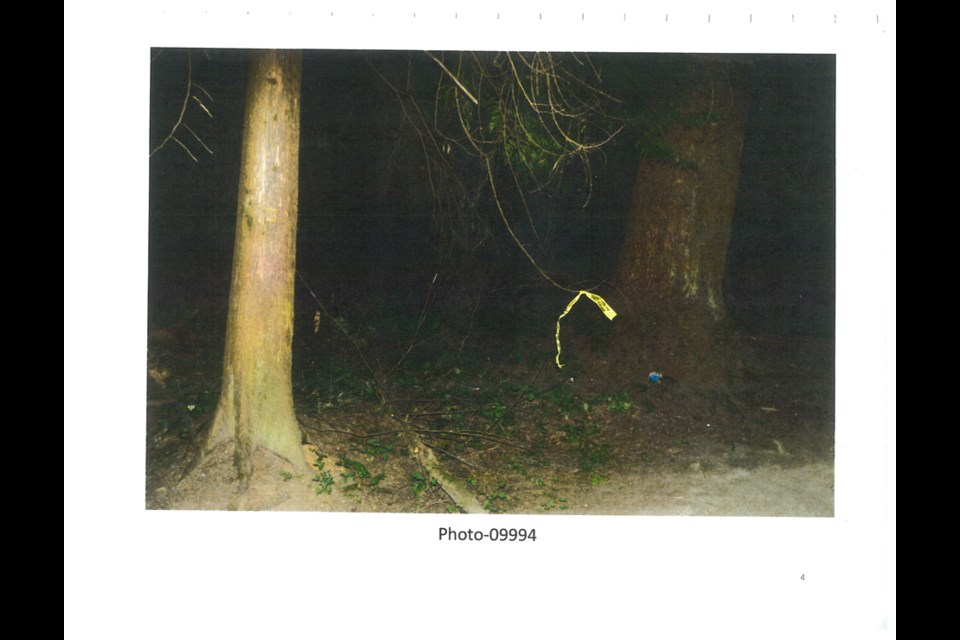Advisory: This story includes disturbing details about a murder trial.
Jurors at a Burnaby murder trial were faced with a series of pictures of the half-naked body of a 13-year-old girl found dead in a Burnaby park six years ago.
Cpl. Dominic Toa, a member of the Lower Mainland Integrated Forensic Identification Team, took the stand at the trial of Ibrahim Ali in B.C. Supreme Court in Â鶹´«Ã½Ó³»Wednesday afternoon.
Ali is on trial for first-degree murder in the death of the teen, whose body was found in Burnaby’s Central Park at 1:14 a.m. on July 19, 2017, less than two hours after her family reported her missing.
.
The victim’s identity is protected by a publication ban.
‘Difficult to look at’
In her opening statement last month, Crown prosecutor Isobel Keeley warned the jury they would be shown photos that would be “difficult to look at.”
On Wednesday, each juror was handed a booklet of crime-scene photos taken by Toa.
On page 6 was the first photo Toa took of the victim’s body, which had been found in forest in the southeast area of the park at 1:44 a.m. on July 19, 2017 — less than two hours after her family had reported her missing.
The photo, taken while it was still “pitch” dark, according to Toa, showed the victim on her back, her arms extended out, palms up, with her left arm bent at the elbow about 90 degrees.
“I did notice her hair band was rolled up to her knuckles as well as her hair was flowing to the right,” Toa told the jury.
Toa said the victim’s black T-shirt and sports bra had been pulled up, and her unbuttoned jean shorts and underwear had been pulled down.
What “stood out” to Toa, he said, was that it appeared only the right half of the victim’s underwear had been pulled on properly.
Toa took a total of about 300 scene photos while it was dark and during daylight, and Keeley took him and the jury through images of the victim’s face, torso, legs and buttocks.
Toa noted injuries, including lacerations to the girl’s knees, a cut to her left ring finger and a blood stain on her buttocks.
There was also an unknown substance in the victim’s hair and one of her ears, but a forensic light exam at the scene didn’t indicate the presence of bodily fluids, such has semen or saliva, according to Toa.
Crime scene search
During testimony Wednesday and Thursday, Toa said his job was to document the crime scene, and, besides taking photos, he conducted a search of an area about seven metres in diameter around the body.
“During your search of the area, did you find anything of note?” Keeley asked.
“No, I did not,” Toa said.
Five or six forensic officers also did a “line search” of a larger area around the body, according to Toa.
He said they found two crumpled pieces of paper more than 10 to 14 metres on the other side of a trail from the body and a yellow watch strap found about 30 metres southeast of the body.
“Was anything else brought to your attention?” Keeley asked.
“No, there wasn’t,” Toa said.
While cross-examining RCMP Sgt. Michael Urmson earlier in the week, defence lawyer Kevin McCullough had asked whether Urmson had “noticed all the condom wrappers around the scene.”
Urmson said no, he hadn't searched the area because that wasn’t his role.
Urmson also told the court Toa had told him there were abrasions to the victim’s knees and that it was Toa's opinion they "may be drag marks."
Under cross-examination Thursday, however, Toa said he had no recollection of talking to Urmson.
He maintained he had formed no opinion about the crime scene but was only there to document it objectively.
, which has not been proven, is that Ali, who was a stranger to the victim, attacked the 13-year-old in Central Park, dragged her into the forest and strangled her to death while sexually assaulting her.
The trial continues.
Follow Cornelia Naylor on Twitter
Email [email protected]



